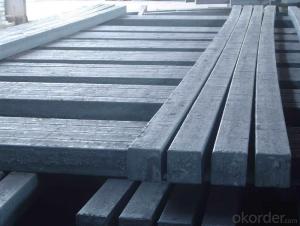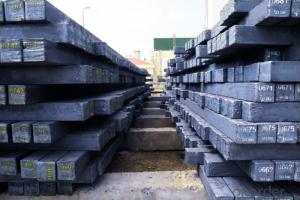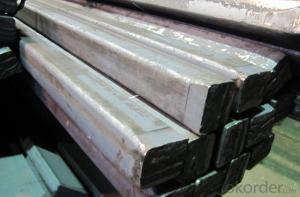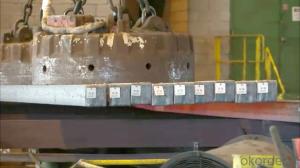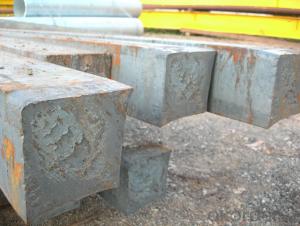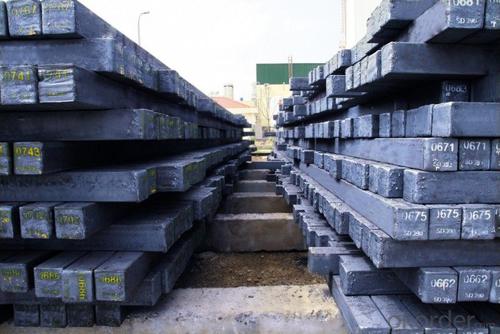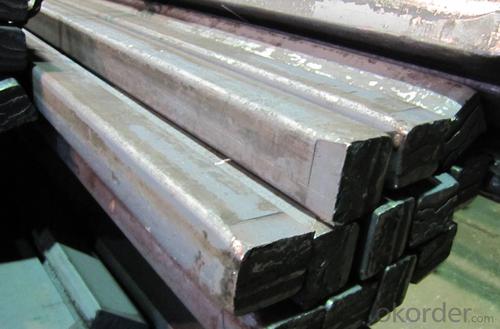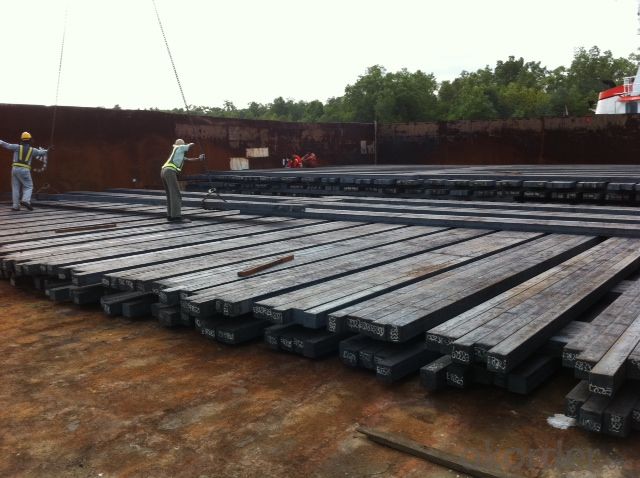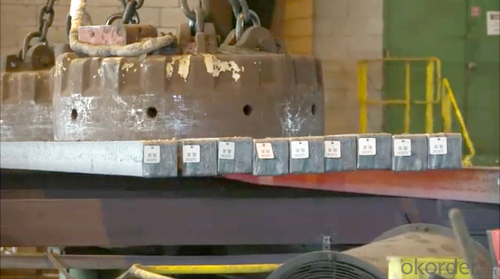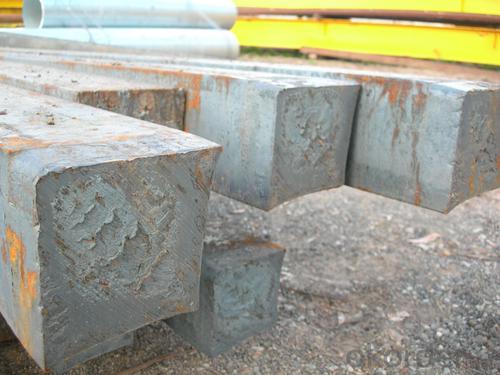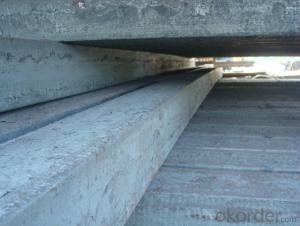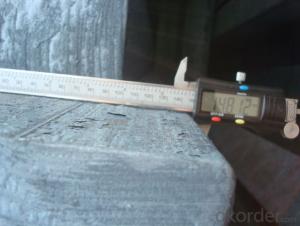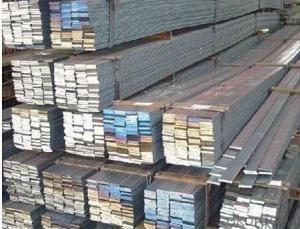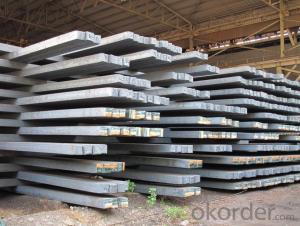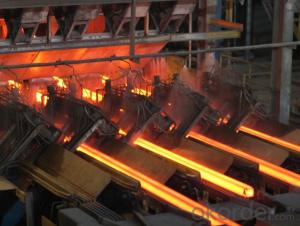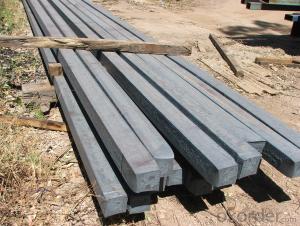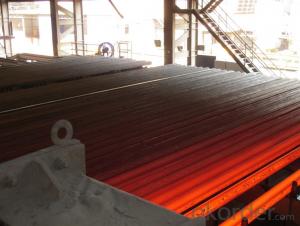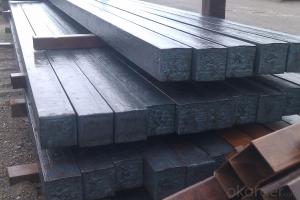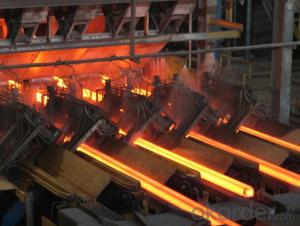Prime Q275 155mm Square Alloy Steel Billet
- Loading Port:
- Shanghai
- Payment Terms:
- TT OR LC
- Min Order Qty:
- 100 m.t.
- Supply Capability:
- 10000 m.t./month
OKorder Service Pledge
OKorder Financial Service
You Might Also Like
Structure of Prime Q275 155mm Square Alloy Steel Billet
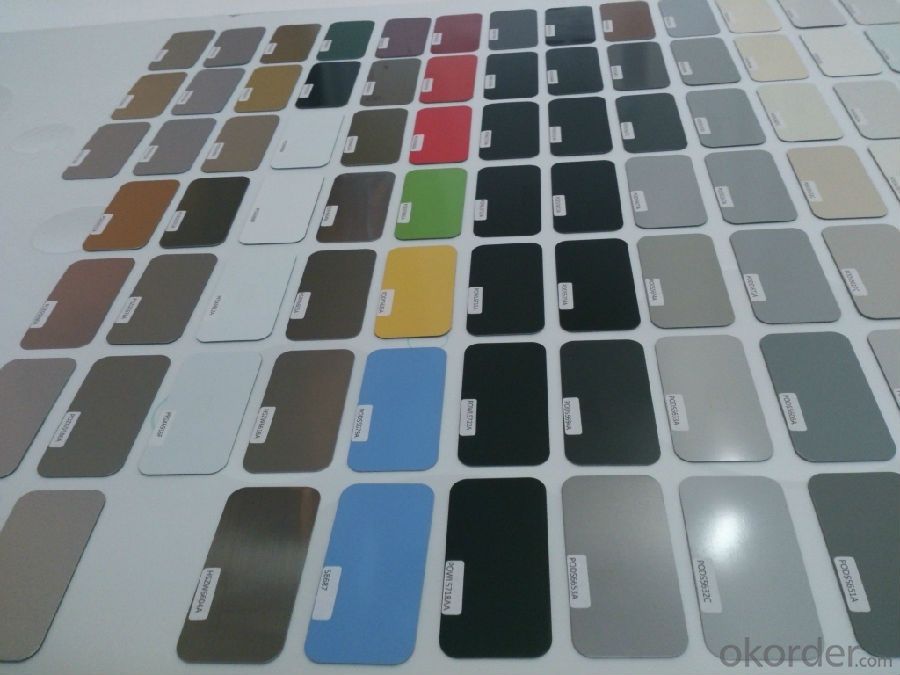
Description of Prime Q275 155mm Square Alloy Steel Billet
1. Prepainted steel coil is coated with organic layer, which provides higher anti-corrosion property and a longer lifespan than that of galvanized or galvalume steel sheets.
2. The base metals for prepainted steel coil consist of cold rolled, HDGI Steel, electro-galvanized and hot-dip alu-zinc coated steel. The finish coats of prepainted steel coil can be classified into groups as follows: polyester, silicon modified polyesters, polyvinylidene fluoride, high-durability polyester, etc.
3. The production process has evolved from one-coating-and-one-baking to double-coating-and-double-baking, and even three-coating-and-three-baking.
4. The color of the prepainted steel coil has a very wide selection, like orange, cream-colored, dark sky blue, sea blue, bright red, brick red, ivory white, porcelain blue, etc.
5. The prepainted steel coils can also be classified into groups by their surface textures, namely regular prepainted sheets, embossed sheets and printed sheets.

Main Feature of Prime Q275 155mm Square Alloy Steel Billet
They were one of several reasons for the wind to be taken out of the sails of the recent oil price momentum. Kuwait’s oil minister said that his country would only commit to a production freeze if all major producers are involved, including Iran. We also had Goldman telling us that oil markets will not rebalance at $40/bbl as it throws a lifeline to cash-strapped US producers.
If it is talk of a production freeze that is behind the rally it shows how low expectations have fallen. It is in the nature of oil people to talk the market up. Any bullish crumb is given exaggerated significance and any port in a storm will do. It is all but fact that the oil market will be tighter in the second half of this year when seasonal demand shoots up and US production continues to decline. It was the same picture last year. If OPEC and key non-OPEC production is frozen that will ensure the daily surplus will fall, but in all likelihood there will still be a surplus and there is an enormous global stockbuild to burn off.
Applications of Prime Q275 155mm Square Alloy Steel Billet
A. Corrugated design makes it excellent waterproof performance
B. Materials as prepainted steel sheets, galvanized steel sheets, galvalume (Al-Zn coated sheets) are available to make corrugated sheet.
C.Those material are durable, anti-corrosion in bad weather for 20-30 years based on it's Zinc(Galvanized) coating or AZ (Galvalume) coating.
D. Different shape of the sheet make it suitable for any style of buildings.
E.Easy to install, no need special tools to fix the sheet.
F.Light weight due to high strength to weight ratio of steel. Light weight means easier handling lower shipping costs, easier installation
G. Different color is availbe base on the RAL Standard make your building more beautiful.
H. We will provide the best solutions if you don't have a exact idea of the specification you want for the steel sheet based on your weather conditions, engineering structure, construction budget and so on.
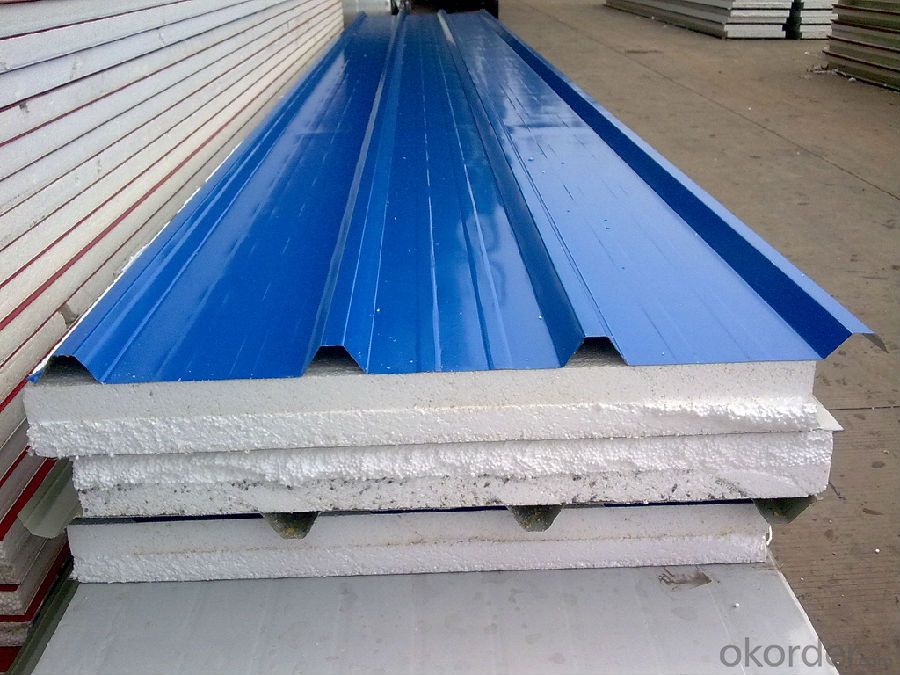
Specifications of Prime Q275 155mm Square Alloy Steel Billet
Product | Billet |
Material Grade | SGCC / SGCH / DX51D+AZ, etc |
Thickness | 0.6-3.0mm |
Width | 500-1500mm |
Tolerance | Thickness: +/-0.02mm , Width:+/-2mm |
Zinc-coating | Z30-150g/m2 |
Technique | Raw material: Hot rolled steel coil --> Cold rolled_>hot dipped galvalume |
Surface | Dried, Chromated, Unoiled |
Spangle | Regular spangle , small spangle, zero spangle |
ID | 508MM 610MM |
Coil weight | 1-25MT |
Export package | Cardboard inner sleeves, Waterproof paper, galvanized steel covered and steel strip packed |
FAQ of Prime Q275 155mm Square Alloy Steel Billet
We have organized several common questions for our clients,may help you sincerely:
1. How Can I Visit There?
Our company is located in Tianjin City, China, near Beijing. You can fly to Tianjin Airport Directly. All our clients, from home or aboard, are warmly welcome to visit us!
2. How Can I Get Some Sample?
Poor trade figures from China punctured commodity optimism yesterday although they came with warnings that perhaps the numbers were distorted by Chinese New Year celebrations and we will have to wait for the March figures to gain a true picture of the state of China’s landing. Exports for February were -25.4% and imports -13.8% year-on-year.
- Q: What is the role of steel billets in the manufacturing of cutting tools?
- Steel billets play a crucial role in the manufacturing of cutting tools. They serve as the raw material from which the cutting tool is forged or machined. Steel billets are typically made from high-quality steel alloys, which possess properties like hardness, toughness, and wear resistance that are essential for cutting tools. The first step in the manufacturing process involves heating the steel billets to a specific temperature, known as the forging temperature. This temperature allows the steel to become malleable, making it easier to shape and form into the desired cutting tool. The heated billets are then subjected to a forging process, where they are struck or pressed using specialized equipment to shape them into the desired form, such as drills, saws, or blades. After the initial forging, the billets are further machined to refine their shape and dimensions. Machining processes like milling, turning, and grinding are used to remove excess material, achieve the precise dimensions required for the cutting tool, and create the desired cutting edge geometry. The quality of the steel billets used in the manufacturing process greatly influences the performance and durability of the cutting tool. Steel billets with high carbon content and alloying elements like chromium, vanadium, or tungsten are often preferred, as they enhance the hardness, strength, and wear resistance of the cutting tool. These properties are crucial for ensuring that the cutting tool can withstand the high forces, temperatures, and abrasive conditions it will encounter during use. In summary, steel billets are the starting point for manufacturing cutting tools. They provide the necessary raw material and properties required to create high-quality cutting tools that exhibit excellent performance, durability, and precision.
- Q: How are steel billets used in the production of automotive frames?
- Steel billets are used in the production of automotive frames as a primary raw material. Billets are essentially long, rectangular-shaped pieces of steel that are heated and then formed into specific shapes through various manufacturing processes. In the case of automotive frames, these billets are typically heated and then passed through a series of dies and rollers to form the desired shape and dimensions. Once the billets are formed into the appropriate shape, they are further processed through cutting, bending, and welding techniques to create the intricate and sturdy structure of an automotive frame. The use of steel billets in the production of automotive frames is preferred due to the high strength and durability properties of steel, which are crucial for ensuring the safety and structural integrity of the vehicles. Moreover, steel billets offer excellent formability and machinability, allowing manufacturers to create complex frame designs that meet the specific requirements of different vehicle models. Additionally, steel is a cost-effective material, making it a popular choice for mass production in the automotive industry. Overall, steel billets play a vital role in the production of automotive frames by providing a strong and reliable foundation for the vehicle's structure. The use of these raw materials, along with advanced manufacturing techniques, ensures that automotive frames are able to withstand various forces and impacts, ultimately contributing to the overall safety and performance of the vehicles.
- Q: What is the global production and consumption of steel billets?
- Steel billets play a crucial role in the worldwide construction and manufacturing sectors, with their production and consumption being of great significance. When it comes to manufacturing, several countries are major players in the production of steel billets. China, the largest producer of steel globally, contributes significantly to the global steel billet production. Other notable producers include India, Japan, Russia, the United States, and Turkey. These countries have well-established steel industries and infrastructure to support large-scale production. The consumption of steel billets is driven by the demand for steel products in various sectors. The construction and infrastructure development sectors are the primary drivers, as steel is widely used in the construction of buildings, bridges, roads, and other structures. The automotive industry is also a major consumer, utilizing steel billets for manufacturing automobile parts and components. Providing an exact figure for global steel billet production and consumption is challenging due to the ever-changing market dynamics and varying industry reports. However, it is estimated that global steel production exceeded 1.8 billion metric tons in 2020, with a significant portion of this production in the form of steel billets. The consumption of steel billets is closely linked to overall steel demand, which is influenced by economic growth, infrastructure development, industrial activity, and construction projects worldwide. In conclusion, the global production and consumption of steel billets are of great significance, highlighting the importance of steel as a vital material in various industries. The continuous growth in infrastructure development and industrialization globally is expected to further drive the production and consumption of steel billets in the years to come.
- Q: How are steel billets used in the manufacturing of medical equipment?
- Steel billets are used in the manufacturing of medical equipment as a raw material that can be shaped and machined into various components such as surgical instruments, implants, and medical device casings. The high strength and durability of steel make it suitable for producing equipment that requires precision, reliability, and resistance to corrosion.
- Q: What are the different grades of steel used for making billets?
- There are several different grades of steel used for making billets, including low carbon steel, mild steel, medium carbon steel, high carbon steel, and alloy steel. The specific grade chosen depends on the desired properties and characteristics required for the intended application of the billets.
- Q: What are the main factors affecting the surface finish of steel billets?
- The main factors affecting the surface finish of steel billets include the quality and cleanliness of the raw materials used, the temperature and pressure during the production process, the type and condition of the equipment used for processing, and the skill and expertise of the personnel involved in handling and finishing the billets. Additionally, factors such as the presence of impurities, chemicals, or contaminants, as well as the use of lubricants or surface treatments, can also impact the surface finish of steel billets.
- Q: What are the different surface treatments applied to alloy steel billets?
- Enhancing the properties and performance of alloy steel billets can be achieved through various surface treatments. One commonly used treatment involves bombarding the billet surface with small metal or ceramic particles at high velocity, a process known as shot blasting. This effectively eliminates impurities and contaminants, resulting in a clean and uniform surface finish. Additionally, shot blasting promotes the adhesion of subsequent coatings or treatments. Another method, known as pickling, entails immersing the billets in an acid solution to remove oxides and scale from the surface. This not only improves the surface quality but also eliminates any defects, preparing the billets for further processing or treatments. Heat treatment is a popular surface treatment for alloy steel billets. By subjecting the billets to controlled heating and cooling processes, their microstructure can be altered, leading to improved mechanical properties. This treatment can enhance the hardness, strength, and toughness of the billets, rendering them more suitable for specific applications. Furthermore, alloy steel billets can be coated with protective coatings to enhance corrosion resistance and durability. Common techniques include hot-dip galvanizing, electroplating, and painting. These coatings serve as a barrier between the alloy steel surface and the environment, effectively preventing corrosion and extending the lifespan of the billets. To summarize, shot blasting, pickling, heat treatment, and protective coatings are among the various surface treatments applied to alloy steel billets. These treatments enhance surface quality, improve mechanical properties, and protect against corrosion, ensuring optimal performance in diverse applications.
- Q: What are the environmental impacts of manufacturing steel billets?
- The manufacturing of steel billets has several environmental impacts. The process involves significant energy consumption, which often relies on non-renewable sources, leading to high greenhouse gas emissions. Additionally, the extraction and processing of raw materials, such as iron ore and coal, can cause habitat destruction, deforestation, and water pollution. Furthermore, the production of steel billets generates waste and byproducts, including slag and dust, which can have detrimental effects on air and water quality if not properly managed. Overall, the manufacturing of steel billets has notable environmental implications that need to be addressed through sustainable practices and technological advancements.
- Q: What are the specifications for steel billets used in the aerospace industry?
- The specifications for steel billets used in the aerospace industry are highly precise and stringent. These billets are required to meet specific standards in order to ensure the safety and durability of aircraft components. First and foremost, the steel used for aerospace billets must have exceptional strength and toughness. It should have a high tensile strength and be capable of withstanding extreme forces and stresses that may be encountered during flight. The steel must also have excellent fracture resistance to minimize the risk of catastrophic failure. Additionally, the steel billets must possess excellent resistance to corrosion and oxidation. This is crucial as aircraft often operate in harsh environments, including high altitudes and exposure to various chemicals. The steel should be resistant to rust, pitting, and other forms of degradation that can compromise its structural integrity over time. Furthermore, the steel billets used in aerospace applications must have precise dimensional tolerances and uniformity. The billets should be manufactured to exact specifications to ensure consistency in the production of aircraft components. This includes the size, shape, and surface finish of the billets, which are crucial for proper fitting and assembly. In terms of chemical composition, the steel used for aerospace billets may vary depending on the specific application and component being manufactured. However, it typically includes elements such as carbon, manganese, chromium, nickel, and molybdenum. These alloying elements enhance the mechanical properties of the steel, such as hardness, toughness, and heat resistance. Furthermore, the steel billets used in the aerospace industry undergo rigorous testing and quality control procedures. This includes non-destructive testing methods like ultrasonic inspection, magnetic particle inspection, and dye penetrant inspection to detect any internal defects or discontinuities. In summary, the specifications for steel billets used in the aerospace industry involve exceptional strength, toughness, corrosion resistance, dimensional accuracy, and precise chemical composition. These strict requirements ensure the reliability and safety of aircraft components, making them capable of withstanding the demanding conditions faced during flight.
- Q: How do steel billets contribute to the infrastructure development sector?
- Steel billets play a crucial role in the infrastructure development sector in several ways. Firstly, steel billets are the primary raw material used in the production of various construction materials such as rebars, beams, and columns. These materials are essential for the construction of buildings, bridges, roads, and other infrastructure projects. The use of steel billets ensures the strength, durability, and stability of these construction materials. Steel has exceptional tensile strength, which makes it ideal for withstanding heavy loads and adverse weather conditions. This, in turn, contributes to the safety and longevity of infrastructure projects. Moreover, steel billets are versatile and can be easily customized according to specific project requirements. They can be shaped into different forms and sizes, allowing engineers and architects to design structures with precision and efficiency. This flexibility enables the construction industry to create complex and innovative designs, enhancing the overall aesthetic appeal of infrastructure projects. Steel billets also contribute to the sustainability of the infrastructure development sector. Steel is a highly recyclable material, and the use of recycled steel reduces the demand for virgin materials and minimizes environmental impact. Additionally, steel structures can be dismantled and reused in other projects, promoting resource efficiency and reducing waste. Furthermore, the availability and affordability of steel billets make them an attractive choice for infrastructure development. Steel is widely produced and distributed, ensuring a steady supply for construction projects. The cost-effectiveness of steel billets allows for the construction of infrastructure projects within budget constraints, ensuring cost efficiency for both private and public investments. In conclusion, steel billets play a vital role in the infrastructure development sector by providing the necessary raw material for construction materials, ensuring strength and durability, allowing for customization and innovation, promoting sustainability, and offering cost-effectiveness. The use of steel billets contributes significantly to the growth and advancement of the infrastructure sector, enabling the construction of safe, resilient, and visually appealing structures that support economic development and improve the quality of life for communities.
Send your message to us
Prime Q275 155mm Square Alloy Steel Billet
- Loading Port:
- Shanghai
- Payment Terms:
- TT OR LC
- Min Order Qty:
- 100 m.t.
- Supply Capability:
- 10000 m.t./month
OKorder Service Pledge
OKorder Financial Service
Similar products
Hot products
Hot Searches
Related keywords
